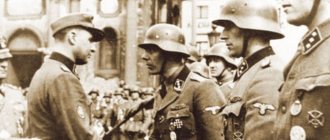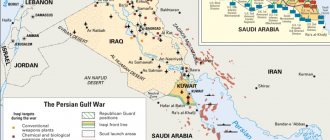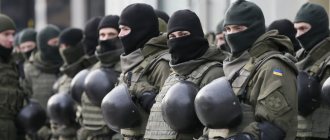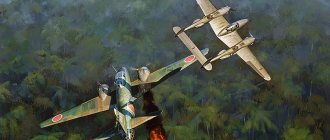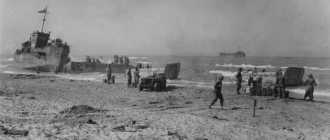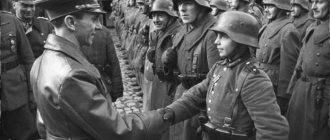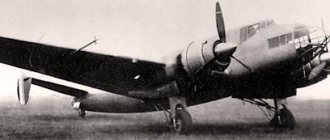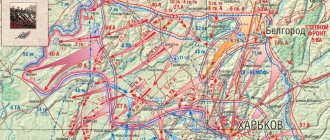The Normandy Landings, or Operation Neptune, was an amphibious assault carried out on June 6, 1944 (D-Day) in Normandy, France, during World War II by the United States, Great Britain, Canada, and their allies.
The large-scale amphibious assault was the first part of the strategic Operation Overlord, according to the plan of which the entire north-west of France was to be liberated.
D-Day - Operation Overlord facts:
- 156 thousand people were landed on the shores of Normandy (73 thousand Americans, 62 thousand British, 21 thousand Canadians), with 24,500 of them landing from the air.
- The heaviest fighting during the landing took place in the Omaha sector (this is where the film Saving Private Ryan takes place).
- The landing operation involved 6,939 ships (whose crews totaled 195,700 sailors), 11,590 aircraft and landing gliders;
- Allied casualties amounted to 4,413 dead and missing, and 5,836 wounded.
The Allies' Operation Neptune amphibious assault began on June 6, 1944, with the landing of 156,000 troops on the northwest coast of Normandy. At the first stage of the operation, an airborne assault force consisting of 24 thousand American, British, Canadian and French paratroopers was dropped at night in the first hours of June 6, 1944, and at the second stage the amphibious assault began at 6:30 am.
The amphibious landing was carried out on a section of coast 80 km wide between the mouth of the Orne River and the commune of Ozville. The landing zone was divided into five main invasion sectors: Utah, Omaha, Gold, Juneau and Sword.
Preparing troops for the Normandy landings
Preparations for the Allied landings in Normandy went on for several months; before this, no one had carried out such large-scale landing operations in the entire history of the Second World War.
Decrypted aerial photograph of the Normandy coastline, Queen Sector of Sword Beach, Lyon-sur-Mer and La Breche-d'Hermanville area.
Personnel were prepared and trained, the rate of production of weapons and ammunition was increased, special landing craft were built in an emergency mode - in total, in 1944, about 30 thousand units of various landing craft and landing craft were built for a successful assault on coastal defenses.
English port during preparations for Operation Neptune (@ US National Archives)
In preparation for Operation Neptune, new amphibious tanks, armored engineering vehicles for creating passages in minefields, special barges with multiple launch rocket launchers, and much more were developed and built. It was truly a war of engines, without which the landing operation would have been doomed to failure. Fuel was needed for these engines, so it was prepared, and with the beginning of the landing in Normandy, oil pipelines were laid along the bottom of the English Channel 20 for an uninterrupted supply of fuel to the troops - the operation to provide the landing troops with fuel and lubricants was called “Pluto” and was implemented in collaboration between scientists, oil company experts and representatives of the US and UK armed forces.
American Rangers aboard British LCA landing craft at Weymouth Port
At the end of May - beginning of June 1944, the allied troops were redeployed to assembly areas (at a distance of 20-25 km from the landing points on transport ships), and about 7,000 anti-aircraft guns and over 1,000 balloons were deployed to cover them from the air.
The French Resistance provided significant assistance to the Allies
The sabotage campaigns launched parallel to D-Day by the French Resistance movement were part of the Allied success in Normandy.
Locomotives damaged by members of the French Resistance in Normandy / Photo: Imperial War Museum © ZZZ 11837E
Among other things, these included acts of sabotage on railways in occupied France and the destruction of electrical equipment and telephone cables used by German forces.
On June 6-7, fifty locomotives were destroyed in the region, and railway communications were cut in more than 500 places. Normandy turned out to be largely isolated, which made it difficult to strengthen German troops in the landing zone of the anti-Hitler coalition forces.
In addition, the French resistance provided the Allies with important intelligence that aided the planning of the operation and facilitated the further advance of the landed troops into France.
Misinformation about the time and place of the Allied landings
The joint Allied command was confident that it was impossible to conceal preparations for the invasion and achieve operational surprise for objective reasons, given the scale of the landing and the volume of forces and means necessary for its implementation. But achieving tactical surprise and misinforming about the main directions of the invasion was a completely feasible task.
Dummy Sherman tanks were used in Operation Fortitude to create false field armies (in Edinburgh and southern England) that threatened landings in Norway or the Pas de Calais, allowing the Allies to divert German attention away from Normandy.
The Allied command paid great attention to misinforming and disorienting the enemy!
The disinformation campaign was called "Bodyguard", during the preparation of the main landing, the Allies purposefully and comprehensively launched fake news (on the radio, in the press, both English and American, and in the media of neutral countries) and rumors that the area of invasion of France will become Calais-Boulogne. Support for such a “legend” was even in the fact that British and US aviation began to regularly launch massive air strikes against coastal anti-landing defenses in the Calais-Boulogne area, from May 30 to June 5, 1944, increasing the intensity of the bombing immediately before the landing in Normandy.
In the foreground, a Willys MB jeep from the US 5th Engineer Special Brigade medical service boards an LCT landing craft.
To misinform the German command in France, the Allies built false towns and special airfields that could mislead German air or human intelligence about the place and time of the invasion. Some time before the start of Operation Overlord, the British Royal Navy and the US Navy began demonstrative departures of their naval forces into the sea, which exhausted the Wehrmacht's coastal defense forces and ultimately reduced the enemy's vigilance.
“The promised one has been waiting for three years”
However, Soviet soldiers greeted the news that the British and Americans had landed in France, remembering the proverb “They wait three years for the promised.”
After the surrender of France on June 21, 1940, land fighting in Western Europe virtually ceased. The whole question was what Hitler next - attack the USSR or try to land in Great Britain.
Article on the topic
Even they fought for their homeland. “Small” countries participating in World War II
The news of Germany's attack on the USSR on June 22, 1941 made British Prime Minister Winston Churchill breathe a sigh of relief. Wehrmacht forces engaged in operations on the Eastern Front no longer threatened Foggy Albion.
However, Britain was interested in the Soviet Union holding out as long as possible, exhausting the strength of the Wehrmacht.
As a result, the anti-Hitler coalition, based on the alliance of Great Britain, the USSR and the USA, was finally created.
In the extremely difficult conditions of the first months of the Great Patriotic War, the issue of opening a “second front” was extremely important for Moscow. Joseph Stalin first used this expression on September 3, 1941 in a letter to Churchill. Speaking about the difficult situation in which the USSR found itself, the Soviet leader wrote: “There is only one way out of this situation: to create a second front somewhere in the Balkans or in France this year.”
From that moment on, a three-year history of broken promises began. The Allies, and above all Great Britain, time after time refused to start hostilities in France.
Normandy landing rehearsal that ended in disaster
For many years, the military departments of the United States and Great Britain hid the terrible facts of a large-scale tragedy during the exercise code-named “Tiger” for the Normandy landings, held in April 1944, in which 749 American soldiers and sailors were killed and the landing ships LST-507, LST were lost -531, LST-289, LST-511 (LST - tank landing ships).
Rehearsal for the Allied landings in Normandy. Exercise Tiger was held at Slapton Sands on the UK coast.
The exercise scenario is as follows: ships arriving at the coast line up along the coast, and shelling of the enemy’s coastal defenses begins. After which the landing begins, and it is covered with artillery fire by a second line of ships firing at enemy territory over the heads of the soldiers who landed on the shore. All personnel put on ammunition in advance, which significantly reduced mobility.
On the night of April 28, 1944, eight large 120-meter landing ships (capable of carrying tanks), loaded with personnel and military equipment, moved from Lyme Bay in the south-east of England to the Slapton Sands area in order to conduct training landing on a coast very similar to the shores of Normandy.
A rehearsal for the landing of a battalion of M10 tank destroyers and several companies of infantry on the sandy beaches at Slapton Sands in England.
The reconnaissance of the German navy managed to detect intense radio traffic in the Tiger exercise area and, after midnight on April 28, sent there a detachment of 9 small E-Boat torpedo boats, which were discovered uncovered from the sea (although the British were supposed to be in the Tiger exercise area destroyer, but by order of the command it went to Plymouth for scheduled repairs) American landing ships stretching 3 miles along the coast.
German torpedo boat E-Boat attacks American landing craft in the Gulf of Lima
There followed a lightning-fast torpedo attack from the German boats, which very quickly were able to shoot 3 of the 8 slow tank landing ships, and after the Americans began returning fire, retreat without suffering losses! The fourth ship, LST-511, was hit by friendly fire from the American LST-496. One of the decisive reasons for the tragedy was the fact that many American tank crews and infantrymen who were on board the sunken landing ships did not know how to swim, did not know the location of life jackets and boats, and were also overloaded with ammunition. As a result, only 240 people were killed as a result of explosions from torpedoes hitting landing ships and under enemy heavy machine gun fire, and more than 500 people simply drowned in the cold waters of the April English Channel.
As a result, the disaster at the Exercise Tiger exercise was classified for 40 years, and only in 1986 did the public learn what actually happened on the night of April 28, 1944 in Lyme Bay. It was only in the late 1980s that a documentary was made about Operation Tiger.
The Americans were planning to be in Berlin for Christmas
As American generals admitted in their memoirs, by this time headquarters were talking about the fact that Berlin could be taken by Christmas.
Such amazing ease of action on the Western Front was explained by the fact that Hitler had nowhere to take reserves from. On June 23, 1944, the Red Army launched Operation Bagration, which turned into a crushing defeat of the Nazis in Belarus. Soviet troops entered Polish territory and quickly liberated the Baltic states. The Germans managed to stabilize the front only in the fall.
And just at this moment the allies also stalled. General Omar Bradley admitted: “September 1944 is marked on our calendars as the month of great bankruptcy... Our push to the Rhine was unsuccessful, and with it our cherished dream of a quick surrender of Germany dissipated.”
Of course, the opening of a “second front” influenced the course of the war. But speaking about the importance of D-Day, we should not forget that ¾ of all human losses, as well as ¾ of losses in military equipment of the Third Reich and its satellites, occurred on the Soviet-German front.
Allied landings on the Normandy coast - D-Day
From 5:20 a.m. On June 6, 1944, the main guns of the artillery support ships opened fire on the German coastal defenses in Normandy.
The artillery strike on the German troops defending on the shore was carried out by: the British battleships Ramiliz and Waspite, the monitor Roberts, the cruisers Arethusa, Danae, Dragon, Morishies, Frobisher; American battleships Arkansas, Nevada, Texas and cruisers Augusta, Scylla and Tuscaloosa.
American Douglas A-20 bombers drop bombs on German positions in Normandy, June 6, 1944. (@ US Army Archives)
At 7 a.m. on June 6, Allied strategic bombers began bombing the front line of enemy coastal defenses in the amphibious landing areas, followed by Allied medium bombers. Allied naval artillery and aircraft were simultaneously operating along the coast. This led to the fact that the main stationary German coastal batteries were suppressed, and return fire on the ships was carried out only by mobile batteries maneuvering in forest areas.
On 6 June 1944, the battleship Warspite was the first to open fire, shelling the German coastal battery at Villerville from a distance of about 24 km, to support the landing of the British 3rd Division in the Sword sector
After this, artillery support guns from cruisers and destroyers, as well as from other warships capable of firing artillery fire at the enemy’s anti-landing defenses, entered the battle.
An American landing craft approaches Omaha Beach, the soldiers' weapons are wrapped in cellophane to prevent them from getting wet. (@ Regional Council of Basse-Normandie / US National Archives)
The landing began with the landing of amphibious tanks (DD tanks - self-propelled amphibious Duplex-Drive tanks) and sappers from the clearing squads, who were supposed to clear the paths for the main landing on the shore.
American landing boats land soldiers on a beach in Normandy under fire from German coastal defenses
Coastal defense forces on the Omaha Coast included 8 sheltered 75 mm artillery batteries, 35 underground concrete fortifications with 75 mm guns, 4 field artillery positions.
German fortifications on the shores of Normandy (@ National Archives USA)
The complex of fortifications included in the Atlantic Wall in this section also included 18 positions for anti-tank guns with calibers from 37 mm to 75 mm, 6 mortar nests, 38 firing points for firing rockets, as well as 85 machine gun nests.
Erwin Rommel inspecting the coastal defenses of Normandy in 1944
The fortifications of the Atlantic Wall, which were to be stormed by the Allies on D-Day, were erected by workers forcibly brought from the occupied territories, and the labor of prisoners of war and soldiers of construction battalions was also used.
German fortifications of the Atlantic Wall in France (@ Bundesarchiv)
By the end of 1943, up to 500,000 people were employed in the construction of the Atlantic Wall, but the Germans failed to completely complete the construction of this gigantic line of fortifications; they managed to build no more than 20% of the planned fortifications.
A British M4 Sherman tank on a barge before landing on a Normandy beach. In the background is the US Coast Guard landing ship LST-21
At 7:33 a.m. on June 6, 1944, the main Allied landing began.
Allied troops land on the Normandy coast
Despite the fact that if on the Utah section the landing of British units took place almost according to plan, without encountering strong resistance, then on the Omaha coast the Americans met fierce resistance from the fascists.
When the American landing craft came close to the shore, the Germans opened heavy fire from artillery guns and machine guns.
Sherman amphibious tank in Normandy
Only five amphibious tanks out of 32 launched were able to reach the shore, the rest were destroyed.
British 4th Brigade commandos go ashore in Normandy near Saint-Aubin-sur-Mer
The losses of Allied landing ships amounted to 291 units, of which: landing craft (LCT) - 131, landing craft (LCA) - 117, small landing craft for infantry - 22, large landing craft for infantry - 21.
The morning of June 7 after the Allied landings on the Normandy beachhead (@ US Navy Archives)
American troops managed to suppress the resistance of the German coastal defense in the Omaha sector only by 13:00 on June 6, 1944.
Victor Surenkov
The worst thing, apart from a lost battle, is a won battle.
Duke of Wellington.
Allied landings in Normandy, Operation Overlord, D-Day, Normandy Operation. This event has many different names. This is a battle that everyone knows about, even outside the countries that fought the war. This is an event that claimed many thousands of lives. An event that will go down in history forever.
general information
Operation Overlord was a military operation of the Allied forces, which became the opening operation of a second front in the West. Held in Normandy, France. And to this day it is the largest landing operation in history - in total more than 3 million people were involved. The operation began on June 6, 1944 and ended on August 31, 1944 with the liberation of Paris from the German occupiers. This operation combined the skill of organizing and preparing for combat operations of the Allied troops and the rather ridiculous mistakes of the Reich troops, which led to the collapse of Germany in France.
Goals of the warring parties
For the Anglo-American troops, Overlord aimed to deliver a crushing blow to the very heart of the Third Reich and, in cooperation with the Red Army's advance along the entire eastern front, to crush the main and most powerful enemy from the Axis countries. The goal of Germany, as the defending side, was extremely simple: not to allow the Allied troops to land and gain a foothold in France, to force them to suffer heavy human and technical losses and dump them into the English Channel.
Strengths of the parties and the general state of affairs before the battle
It is worth noting that the position of the German army in 1944, especially on the Western Front, left much to be desired. Hitler concentrated his main troops on the eastern front, where Soviet troops were victorious one after another. The German troops were deprived of a unified leadership in France - constant changes in senior commanders, conspiracies against Hitler, disputes about a possible landing site, and the lack of a unified defensive plan did not in any way contribute to the successes of the Nazis.
By June 6, 1944, 58 Nazi divisions were stationed in France, Belgium and the Netherlands, including 42 infantry, 9 tank and 4 air field divisions. They were united into two army groups, “B” and “G”, and were subordinate to the “West” command. Army Group B (commander Field Marshal E. Rommel), located in France, Belgium and the Netherlands, included the 7th, 15th armies and the 88th separate army corps - a total of 38 divisions. Army Group G (commanded by General I. Blaskowitz) consisting of the 1st and 19th armies (11 divisions in total) was located on the coast of the Bay of Biscay and in southern France. In addition to the troops that were part of the army groups, 4 divisions made up the reserve of the West command. Thus, the greatest densities of troops were created in North-Eastern France, on the coast of the Pas-de-Calais Strait. In general, the German units were scattered throughout France and did not have time to arrive on the battlefield in time. For example, about 1 million more Reich soldiers were in France and initially did not participate in the battle.
Despite the relatively large number of German soldiers and equipment stationed in the area, their combat effectiveness was extremely low. 33 divisions were considered “stationary”, that is, they either had no vehicles at all or did not have the required amount of fuel. About 20 divisions were newly formed or recovered from battles, so they were only 70-75% of normal strength. Many tank divisions also lacked fuel. From the memoirs of the Chief of Staff of the West Command, General Westphal: “It is well known that the combat effectiveness of the German troops in the West at the time of the landing was much lower than the combat effectiveness of the divisions operating in the East and Italy... A significant number of ground forces located in France, the so-called “stationary divisions” were very poorly equipped with weapons and vehicles and consisted of older soldiers.” The German air fleet could provide about 160 combat-ready aircraft. As for the naval forces, Hitler's troops had at their disposal 49 submarines, 116 patrol ships, 34 torpedo boats and 42 artillery barges.
The Allied forces, commanded by future US President Dwight Eisenhower, had 39 divisions and 12 brigades at their disposal. As for aviation and navy, in this aspect the Allies had an overwhelming advantage. They had about 11 thousand combat aircraft, 2300 transport aircraft; over 6 thousand combat, landing and transport ships. Thus, by the time of the landing, the overall superiority of the Allied forces over the enemy was 2.1 times in men, 2.2 times in tanks, and almost 23 times in aircraft. In addition, the Anglo-American troops constantly brought new forces to the battlefield, and by the end of August they already had about 3 million people at their disposal. Germany could not boast of such reserves.
Operation plan
The American command began preparing for the landing in France long before D-Day itself (the initial landing project was considered 3 years before - in 1941 - and was codenamed "Roundup"). In order to test their strength in the war in Europe, the Americans, together with British troops, landed in North Africa (Operation Torch), and then in Italy. The operation was postponed and changed many times because the United States could not decide which theater of military operations was more important for them - the European or the Pacific. After the decision was made to choose Germany as the main rival, and in the Pacific to limit itself to tactical defense, the plan for the development of Operation Overlord began.
The operation consisted of two phases: the first was codenamed "Neptune", the second - "Cobra". "Neptune" assumed an initial landing of troops, the capture of coastal territory, "Cobra" - a further offensive deep into France, followed by the capture of Paris and access to the German-French border. The first part of the operation lasted from June 6, 1944 to July 1, 1944; the second began immediately after the end of the first, that is, from July 1, 1944 until August 31 of the same year. The operation was prepared in the strictest secrecy, all troops that were supposed to land in France were transferred to special isolated military bases that were forbidden to leave, information propaganda was conducted regarding the place and time of the operation. In addition to US and British troops, Canadian, Australian and New Zealand soldiers took part in the operation, and French resistance forces were active in France itself. For a very long time, the command of the allied forces could not accurately determine the time and place of the start of the operation. The most preferred landing sites were Normandy, Brittany and Pas-de-Calais. Everyone knows that the choice was made on Normandy. The choice was influenced by factors such as the distance to the ports of England, the echelon and strength of defensive fortifications, and the range of the Allied aircraft. The combination of these factors determined the choice of the Allied command. Until the very last moment, the German command believed that the landing would take place in the Pas-de-Calais area, since this place was closest to England, and therefore required the least time to transport cargo, equipment, and new soldiers. In Pas-de-Calais, the famous “Atlantic Wall” was created - an impregnable line of defense for the Nazis, while in the landing area the fortifications were hardly half ready. The landing took place on five beaches, which were codenamed “Utah”, “Omaha”, “Gold”, “Sword”, “Juno”. The start time of the operation was determined by the ratio of the water level and the time of sunrise. These factors were considered to ensure that the landing craft did not run aground and were not damaged by underwater obstacles, and that it was possible to land equipment and troops as close to the shore as possible. As a result, the day the operation began was June 6, and this day was called “D-Day.” The night before the landing of the main forces, a parachute landing was dropped behind enemy lines, which was supposed to help the main forces, and immediately before the start of the main attack, the German fortifications were subjected to a massive air raid and shelling by Allied ships.
Progress of the operation
Such a plan was developed at headquarters. In reality, things didn't go quite that way. The landing force, which was dropped behind German lines the night before the operation, was scattered over a vast territory - over 216 square meters. km. for 25-30 km. from captured objects. Most of the 101st Division, which landed near Sainte-Maire-Eglise, disappeared without a trace. The 6th British Division was also unlucky: although the landing paratroopers were much more numerous than their American comrades, in the morning they came under fire from their own aircraft, with which they could not establish contact. The 1st US Division was almost completely destroyed. Some ships with tanks were sunk before they even reached the shore. Already during the second part of the operation - Operation Cobra - Allied aircraft attacked their own command post. The offensive went much slower than planned. The bloodiest event of the entire company was the landing on Omaha Beach. According to the plan, early in the morning, German fortifications on all beaches were subjected to fire from naval guns and air bombing, as a result of which the fortifications were significantly damaged. But on the Omaha, due to fog and rain, the naval guns and planes missed, and the fortifications did not receive any damage. By the end of the first day of the operation, on the Omaha the Americans had lost more than 3 thousand people and were unable to take the positions planned by the plan, while on the Utah during this time they lost about 200 people, took the necessary positions and united with the landing party. Despite all this, on the whole the landing of the Allied troops was quite successful. Then the second phase of Operation Overlord was successfully launched, within the framework of which cities such as Cherbourg, Saint-Lo, Caen and others were taken. The Germans retreated, throwing weapons and equipment to the Americans. On August 15, due to mistakes by the German command, two German tank armies were surrounded, and although they were able to escape from the so-called Falaise Pocket, it was at the cost of huge losses. Allied forces then captured Paris on August 25, continuing to push the Germans back to the Swiss borders. After the French capital was completely cleared of fascists, Operation Overlord was declared completed.
Reasons for the victory of the Allied forces
Many of the reasons for the Allied victory and the German defeat have already been mentioned above. One of the main reasons was the critical position of Germany at this stage of the war. The main forces of the Reich were concentrated on the Eastern Front; the constant onslaught of the Red Army did not give Hitler the opportunity to transfer new troops to France. Such an opportunity arose only at the end of 1944 (Arden offensive), but then it was already too late. The better military-technical equipment of the Allied troops also had an effect: all the equipment of the Anglo-Americans was new, with full ammunition and a sufficient supply of fuel, while the Germans constantly experienced supply difficulties. In addition, the Allies constantly received reinforcements from English ports. An important factor was the activity of the French partisans, who pretty well spoiled the supplies for the German troops. In addition, the allies had a numerical superiority over the enemy in all types of weapons, as well as in personnel. Conflicts within the German headquarters, as well as the incorrect belief that the landing would take place in the Pas-de-Calais area and not in Normandy, led to a decisive Allied victory.
Operation meaning
In addition to the fact that the landing in Normandy showed the strategic and tactical skill of the command of the Allied forces and the courage of ordinary soldiers, it also had a huge influence on the course of the war. “D-Day” opened a second front, forcing Hitler to fight on two fronts, which stretched the already dwindling forces of the Germans. Overlord was the first major battle in Europe in which American soldiers proved themselves. The offensive in the summer of 1944 caused the collapse of the entire Western Front, the Wehrmacht lost almost all positions in Western Europe.
Cemetery
of American soldiers on Omaha Beach
Representation of the battle in the media
The scale of the operation, as well as its bloodshed (especially on Omaha Beach) led to the fact that today there are many computer games and films on this topic. Perhaps the most famous movie was the masterpiece of the famous director Steven Spielberg, “Saving Private Ryan,” which tells about the massacre that took place at Omaha. This topic was also touched upon in “The Longest Day,” the television series “Band of Brothers” and many documentaries. Operation Overlord has appeared in more than 50 different computer games.
Even though Operation Overlord was carried out more than 50 years ago, and now it remains the largest amphibious operation in the history of mankind, and now the attention of many scientists and experts is focused on it, and now there are endless disputes and debates about it . And it’s probably clear why.
List of used literature
- Max Hastings, Operation Overlord: How the Second Front Was Opened. https://militera.lib.ru/h/hastings_m/index.html
- Materials from the site https://www.normandy-1944.com/
- Article from the magazine “Around the World” “The mysteries of Operation Overlord.” https://www.vokrugsveta.ru/vs/article/861/
- Dwight Eisenhower, Crusade in Europe. https://militera.lib.ru/memo/usa/eisenhower/index.html
- Ralph Ingersoll, Operation Overlord. Seaborne invasion".
- Images taken from the Yandex-images service. https://images.yandex.ru/
Rating 4.00 (4 Votes)
Results of the first days of Operation Overlord
By the end of the day on June 6, 1944, 5 infantry, 3 airborne divisions and a tank brigade were landed in the American and British sectors, with a total of about 200 thousand soldiers and officers, including naval and airborne landings.
The US armed forces numbered 73,000 people in this theater of operations, including 23,250 amphibious landings on Utah Beach, 34,250 landings on Omaha Beach, and 15,500 airborne landings in the depths of Normandy.
An exploded German pillbox on a beach in Normandy. Several German prisoners of war are led away after the capture of the cape (@ Regional Council of Basse-Normandie / US National Archives)
83,115 troops landed on the British and Canadian beachheads (61,715 of them were British troops): 24,970 people - landing on Gold Beach, 21,400 people - landing on Juno Beach, 28,845 people - landing on Sword Beach "and 7900 - airborne assault to the rear of German troops.
American soldiers rest near a German bunker disguised as a house (@ Regional Council of Basse-Normandie / US National Archives)
On D-Day, the Allies managed to capture bridgeheads on the Normandy coast with a depth of 3 to 5 km. The landing zone was completely cleared of the Nazis only the next day, June 7. On June 8, 1944, Anglo-American troops gained a foothold in the bridgehead, continuing to land new troops, military equipment, weapons and ammunition necessary to continue the offensive into the depths of France.
Fall of Shurbur
Meanwhile, the position of German troops on the Normandy coast continued to deteriorate - formations of the 1st American Army, having launched an offensive on June 12 from the area west of the city of Sainte-Mère-Eglise in a westerly direction, occupied the city of Carteret. On June 17, the Americans cut off the Cotentin Peninsula and by June 21 approached Cherbourg. Fort Cherbourg was of enormous strategic importance for the Allied forces, who, due to the lack of ports, were experiencing great problems with supplying their troops on the continent. The next day, after powerful air preparation, the assault on the fortress began. It lasted several days, and on June 25, troops broke into the old forts of the city, built several centuries ago to fight the British. The next day, the city commandant ordered his units to lay down their arms. Individual groups of German troops still continued to resist, but by July 1, these groups were completely eliminated. At the same time, the Americans captured 30 thousand people and on July 1 completed the liberation of the entire territory of the Cotentin Peninsula from German troops.
American ground forces on the offensive
On July 3, the US 1st Army went on the offensive again. In 17 days, her troops advanced 10-15 km southward and occupied the city of Saint-Lo and the important transport hub located near it.
Statistics of the landing operation in Normandy
During such a large-scale landing operation, 11,590 aircraft of various types were involved, which made a total of 14,674 sorties (reconnaissance, bombing, landing, air combat, etc.), and it was precisely for the airborne landing in During the day on June 6, 1944, 2,395 Allied aircraft and 867 gliders were involved.
Allied CG-4A gliders and C-47 aircraft in the skies of France
The US and Royal Navy deployed 6,939 ships, vessels and various craft: 1,213 warships, 4,126 landing craft, 736 auxiliary ships and 864 cargo and supply vessels for the Normandy landings. On all ships involved, 195,700 sailors were involved: 52,889 American, 112,824 British, 4,988 from other countries of the anti-Hitler coalition.
Destroyed train station in the French city of Saint-Lo (@ Regional Council of Basse-Normandie / US National Archives)
All these forces and means made it possible by June 11 to ensure that the Allied military group in France numbered 326,547 military personnel and 54,186 units of combat and auxiliary equipment, as well as vehicles. More than 100,000 tons of ammunition, ammunition and military equipment were delivered to the coast of French Normandy.
Winston Churchill's "Great Game"
In the autumn of 1941, Churchill wrote to Stalin: “In France alone the Germans have forty divisions, and the entire coast has been fortified for more than a year with purely German zeal and bristled with guns and barbed wire... To launch a landing in large forces would mean suffering a bloody defeat, and small raids would only lead to to failure and would cause much more harm than good to both of us.”
Article on the topic
Man with a cigar. How Winston Churchill extended the life of the British Empire
The series of endless excuses continued in 1942 and 1943... Sometimes it came to incredible things. In the summer of 1942, when one of the main battles of the war, the Battle of Stalingrad, was gaining momentum, the army of General Anders . Armed with Soviet money, the allies refused to fight on the Eastern Front, and at the insistence of Great Britain they were evacuated to the Middle East.
In parting, General Anders told Stalin: “The strategic center of gravity of the war is currently moving to the Near and Middle East.”
Military experts believe that, since 1942, statements by the Western allies about the impossibility of landing in France were disingenuous. The US Joint Chiefs of Staff prepared plans for a cross-Channel invasion of Europe in the first half of 1942. However, the Americans ran into a categorical refusal from Great Britain to take part in the operation.
In 1942, the Western Allies were focused on operations in Africa, and in 1943, on the invasion of Italy. These actions did not make the task of the Red Army easier, and did not cause decisive damage to the Wehrmacht.
At the same time, back in March 1942, US President Franklin Roosevelt wrote to Churchill: “I am becoming more and more interested in opening a new front on the European continent this summer... From the point of view of transport and supplies, it will be infinitely easier for us to take part in this, since the maximum distance is only about three thousand miles. And although the losses will undoubtedly be high, they will be compensated by at least the same losses of Germany, as well as by the fact that Germany will be forced to divert large forces of all branches of the military from the Russian front.”
But Churchill skillfully multiplied by “zero” all initiatives to open a “second front” in France.
“We won’t stand behind the price!” How much did Victory in World War II cost the Soviet Union? More details
Losses of both sides during Operation Overlord
According to the latest official data, which was corrected after careful research of archives and combat reports, it was established that during the landing in Normandy, the Allies lost almost 4,500 people (2,5 thousand American troops and 2,000 military personnel from other countries of the anti-Hitler coalition).
The total losses in Operation Overload (during amphibious and airborne assaults) are about 10,000 people (6,603 US troops, 2,700 British soldiers, 946 Canadians), and they include: dead, wounded, missing.
Ruins of the city of Saint-Lo, summer 1944 (@ Regional Council of Basse-Normandie / US National Archives)
Separately, it is worth noting that during the preparation of Operation Neptune (amphibious assault as part of the general Operation Overload) from April to May 1944, the Allies lost almost 12 thousand people killed, wounded and missing.
A chaplain conducts a vigil over the bodies of fallen American paratroopers in Normandy (@ National Archives, College Park, Maryland)
Data on Wehrmacht losses is difficult to estimate, since during the retreat, combat reports from German headquarters were often lost and not recorded by the German General Staff. According to rough estimates, German losses total about 3-4 thousand people killed, wounded and missing.
During the bombing of transport hubs and strategic objects on French territory by Allied aviation as part of Operation Overlode, between 15 and 20 thousand French civilians died, this is the price that the French people had to pay for liberation from the Nazi invaders in 1944.
Operation commanders
Dwight Eisenhower was appointed commander of the Normandy landings. Under his leadership were all the forces of the British, American, and Canadian troops that landed on the coast of France.
It should also be noted that the special army group, led by George Patton, was created in order to disorient the enemy. This largely decided the outcome of the battles on the Normandy coast. There are other units that arrived on French territory after the operation. The 21st Army Group, which included Canadian, British, and American troops, was commanded by Bernard Montgomery.
Bernard Montgomery
On the Wehrmacht side on the Western Front, Adolf Hitler appointed General Field Marshal Gerd von Rundstedt in charge. Erwin Rommel with his Army Group B was in the north of France and had to directly defend its borders from a possible landing on the Normandy coast.
Also, various German military leaders with their divisions and separate battalions were scattered on the French peninsulas and islands to actively and effectively counter the possible landing of Allied troops. Also not far from this region was Army Group G, led in southern France by Johannes Blaskowitz.
Balance of power
Normandy area
was fortified and defended very poorly.
The chain of German coastal fortifications called the “Atlantic Wall”
was “impregnable” only in words. At the time of the operation, only six divisions were defending the Allied landing site. And even those were only two-thirds staffed.
And the total number of attackers reached 3 million people. The superiority in weapons and equipment was threefold. Allied dominance on the water and in the air was overwhelming.
